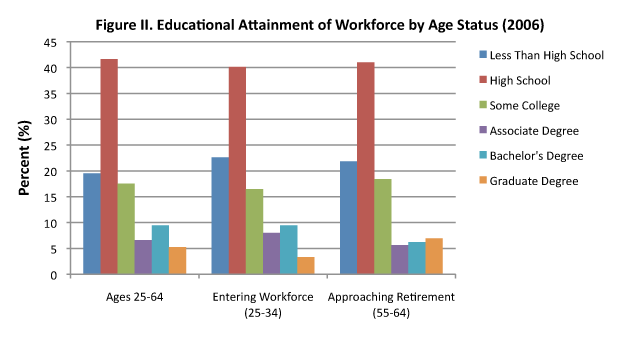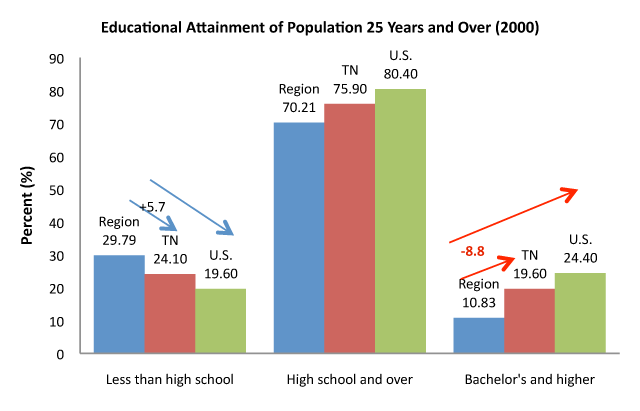It Is Time to Invest in Human Capital
Closing the educational attainment gap: how can southern middle Tennessee, experiencing significant economic decline, emerge as a globally competitive manufacturing region?
Rural America has experienced dramatic changes in its economic landscape. The obvious manifestation of this change is the steady decline of manufacturing sector employment through downsizing, plant closings, relocation of companies overseas, and consolidation of branch operations. Rural regions where traditional manufacturing sectors dominated the economy have been affected by these shifts disproportionally. Although increasing overseas competition and globalization have been seen as the primary triggers in shifting economic dynamics, technological changes further exacerbated the situation in rural areas where basic infrastructure (i.e., information technology, physical infrastructure, human resources) are not up to the challenge of making the transition from traditional manufacturing to a technology-intensive knowledge economy.
For many rural regions, the critical issue is to manage this multifaceted transition in a way that (1) strengthens existing businesses, (2) upgrades workforce skills, (3) addresses small business concerns, and (4) upgrades the aging infrastructure. The ultimate goal is to create employment and wealth. What should these communities do to ensure success? One answer is to understand, evaluate, and address workforce-related issues. Based on my previous study,1 this article highlights some critical issues regarding workforce education in the 14 counties of southern middle Tennessee.
Southern Middle Tennessee at a Glance
Strategically located between Nashville and Huntsville, this region includes the following 14 counties: Bedford, Coffee, Franklin, Giles, Hickman, Lawrence, Lewis, Lincoln, Marshall, Maury, Moore, Perry, Warren and Wayne. Nearly 22 states are within one day's drive from the center of the region, located in Marshall County.
Three major interstates dissect the region: I-65 connecting Nashville and Huntsville, I-24 connecting Nashville and Chattanooga, and I-40 to the north. The region has significant market potential, as nearly 2.5 million people live within a 70-mile radius or one-hour drive from its center.
Once the hub of traditional manufacturing, the southern middle Tennessee counties have experienced major economic setbacks: first, through the flight of manufacturing companies overseas, and second, due to the recent prolonged economic crisis. The manufacturing sector is still the major source of employment, accounting for more than one-third of jobs in Bedford, Giles, Lincoln, Marshall, Perry, and Warren counties as of the third quarter of 2008. In the rest of the counties, employment makes up about 20 percent of the manufacturing sector. Compared to the third quarter of 2005, the manufacturing sector shed nearly 9,000 jobs (a 24 percent decline) in the 14-county region.
These job losses have led to a spike in unemployment in these counties since November 2008. Seven of the 14 counties had an unemployment rate (not seasonally adjusted) 4% higher than that of the U.S. as of February 2009 (Table 1). Only one of the 14 counties registered a rate slightly lower rate than that of the U.S.
Given the extent of job losses and unemployment as well as underemployment, building a globally competitive economy requires a careful look at the region's most important asset: human capital.
Workforce Education in Southern Middle Tennessee
At the heart of any regional economic initiative is the availability and quality of the workforce. This is especially true now due to major economic shifts in rural areas. In the course of this study, the following statement resonated across counties: "We would like to bring high-paying, high-tech jobs to the region." Although this is an extremely desirable goal for rural communities where income and wages are falling behind the national average while the cost of living is increasing, the reality is that many of these communities are significantly lagging behind national averages in workforce education.
This dilemma is very visible in the region, as the desire to have high-paying, high-tech jobs is countered by the educational realities of the workforce. Of course, a less desirable option is to recruit workers with these qualities from other regions.
How is the region performing in terms of workforce education? Table II clearly illustrates the large gap between the study region and Tennessee on one hand and between the study region and the U.S. on the other, in terms of postsecondary education.
Although the 14-county region showed some improvement between 2000 and 2006 in the bachelor's degree and higher educational categories, it is still significantly behind the U.S. average and Tennessee. For example, the number of those over age 25 with a bachelor's degree or higher increased 2.75% in that period. However, the region lagged behind the U.S. 13.6% in 2006 for the same educational attainment level. Figure I illustrates these differences across time and educational attainment levels. One observation is that, compared to the U.S., the region has a significant surplus in less than high school educational attainment and a substantial and stable deficit in bachelor's and higher educational attainment.
Intergenerational Difference in Educational Attainment
While the gap in postsecondary educational attainment is significant compared to both the Tennessee and U.S. average, is there an intergenerational difference in educational attainment levels in the region as well? Figure II looks at educational attainment level by age cohort.

According to Figure II, there is not much change between the entering workforce (ages 25-34) and those approaching retirement (ages 55-64) in the less than high school educational attainment category. The workforce approaching retirement is relatively better off in the high school, some college, and graduate degree categories. The entering workforce is slightly better in the associate's and bachelor's degree categories.
A critical observation is that there is no significant change in the "less than high school" category. An analysis of occupational employment by educational attainment shows that "less than high school" as an educational requirement is no longer part of the official job description for nearly all occupations in the U.S. (www.bls.gov). In order to address employment and wage issues effectively, policies should aim at eliminating the education gap in the region.
Extent of Educational Gap by Occupation
What is the extent of the educational gap in the region? Table III provides a detailed look at the region's employment by occupation and educational attainment. The table also compares the percent of the region's workforce with a college degree or above in each occupational category to that of the U.S. workforce. The large gap indicates that the region has the potential to make significant gains in wages and income by eliminating existing educational gaps in occupational employment.
For example, only 33% of scientists and technicians in the region have a college degree or above as opposed to 79 percent in the U.S. This translates into a gap of 46%, indicating significant room for educational improvement in this occupation. Similarly, the college and above degree gap in legal services occupations is more than 25%, in medical occupations 24%, in sales 25%, and in computer programming and database administration 19%.
Eliminating higher education attainment gaps even in these selected occupations is likely to boost economic dynamics in the region. A synchronized approach to workforce education and cluster strategy is necessary for a successful regional economic development initiative.
Conclusion
The workforce in the southern middle Tennessee counties has a deficit in educational attainment compared to the U.S. In order for these counties, already experiencing significant economic decline, to emerge as a globally competitive manufacturing region, they should develop policies to upgrade skill and education levels of the existing workforce. In doing so, these counties are likely to increase employment opportunities as well as income level for the unemployed and underemployed labor force. Now is the right time to invest in human capital to create a globally competitive regional workforce.
1. Murat Arik and David A. Penn (2008), "Increasing Competitiveness through Strengthening Regional Industrial Clusters: Middle Tennessee Marketing Region," Business and Economic Research Center, MTSU.
* Murat Arik is the associate director of MTSU's Business and Economic Research Center.



